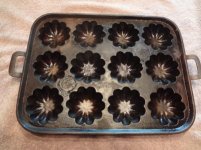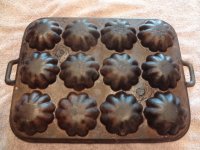-
Amazon Black Friday Week/Cyber Monday Deal Event, running November 21 through Monday, December 2, 2024. Please consider using the CIC link to shop this Amazon event. Or go directly to Black Friday Deals or Cyber Monday Deals. Not a Prime member? Try a Prime 30-day Free Trial Membership.
-
If a web search for the answer to your cast iron cookware question has brought you directly to this forum, the information you seek may be covered in one of the many reference topics featured on the main website.
Quick Links: · Main Website · How to Identify Unmarked Pans · All About Cleaning & Seasoning · Reproductions & Counterfeits · Commonly-Used Terms
You are using an out of date browser. It may not display this or other websites correctly.
You should upgrade or use an alternative browser.
You should upgrade or use an alternative browser.
Gated muffin pan info?
- Thread starter Shawn R
- Start date
Thanks RickC. I agree those are sprue marks. I didn't even consider that when we bought it. Still learning the hobby and sometimes mistakes will happen.
Heck, I've never even heard of sprue marks until this thread. Thanks for sharing!
I know this is dragging up an old thread , but I recently saw this item and was wondering if the information is correct .
http://www.terapeak.com/worth/antiq...iron-turks-head-muffin-pan-aafa/301829518489/
I can't seem to find the link now , but I saw that very item on the big online auction site and it sold for $275 U.S. .
Also if you look on this site
http://www.ramshornstudio.com/index.htm
and go to this page
http://www.ramshornstudio.com/iron_218d.htm
about half way down you will see this
"
Sand casting has existed for many hundreds of years. The basic technique of sand casting iron cookware has changed little over time. The foundry pours molten iron into a mold created in sand to create a piece in a particular design. The mold is created by packing sand, very artfully, around a pattern, often made of wood. When this pattern is removed from the sand it creates the area to be filled with iron in the exact shape of the wooden model. It is in this void the molten iron flows. Amazing detail can be achieved by a skilled artisan. Binders are used mixed in the sand to make the mold hold together long enough for the founder to pour and serves to hold precise detail in the sand. There are many formulas for binders often with clay as a component.
Minor changes in the casting process can show us the approximate date of a piece. The oldest pieces will have a circular "sprue" mark on the underside of the piece. This technique was used until the mid-to late 1700's. Most pieces were cast upside down, to avoid having an unsightly sprue or gate marks on the top of the piece. The sprue is the point where the foundryman poured the molten iron into the mold. It is a sort of pipeline for the metal to flow into the mold itself. Any piece that is cast, even those today, will have at least one point where you can see where the iron entered the mold. Sometimes it is well ground and polished down but you can still find it most of the time.
Many of the pots in use during the late 1700's were designs that evolved from patterns once cast in bronze or bell metal as it is sometimes called. Bronze conducts heat better than iron but vessels made of bronze are far more costly to produce. With the change in metals, the shapes of cooking vessels changed somewhat with the function and the fashion. They mostly remained fairly close to their original forms so one can see how the line of succession progressed. Posnets and three legged kettles continued relatively unchanged all the way into the late 19th Century and very closely resemble the original shapes.
This next generation of cast iron, beginning around the mid 1700's, have a "gate" mark, which looks like a long thin line on the bottom of the piece. This is where the iron entered the mold, and the technique lasted from the mid-1700's to the late 1800's or so. Pieces made around 1875 to the present time were engineered so the iron entered the mold from the sides. It entered usually in two places, sometimes opposite one another. These pieces have a smooth bottom. Current techniques have the iron coming in from the side, so look for one or more places on the sides of the iron pot with heavy grinding marks where the iron entered the mold. The grinding is done to finish the piece so that no unsightly burs or roughness mars the surface. This is a fairly modern development brought about by the ability to cheaply grind ironware. This would have wasted too much valuable time and been next to impossible for an 18th or early 19th Century founder to carry out. "
This seems to back up the muffin pan description .
So................... is this right ? Does anyone have any information that proves or disproves these statements ?
I'm always looking to learn and understand more about cast iron , so I hope someone has some knowledge on the history of gate marks .
http://www.terapeak.com/worth/antiq...iron-turks-head-muffin-pan-aafa/301829518489/
I can't seem to find the link now , but I saw that very item on the big online auction site and it sold for $275 U.S. .
Also if you look on this site
http://www.ramshornstudio.com/index.htm
and go to this page
http://www.ramshornstudio.com/iron_218d.htm
about half way down you will see this
"
Sand casting has existed for many hundreds of years. The basic technique of sand casting iron cookware has changed little over time. The foundry pours molten iron into a mold created in sand to create a piece in a particular design. The mold is created by packing sand, very artfully, around a pattern, often made of wood. When this pattern is removed from the sand it creates the area to be filled with iron in the exact shape of the wooden model. It is in this void the molten iron flows. Amazing detail can be achieved by a skilled artisan. Binders are used mixed in the sand to make the mold hold together long enough for the founder to pour and serves to hold precise detail in the sand. There are many formulas for binders often with clay as a component.
Minor changes in the casting process can show us the approximate date of a piece. The oldest pieces will have a circular "sprue" mark on the underside of the piece. This technique was used until the mid-to late 1700's. Most pieces were cast upside down, to avoid having an unsightly sprue or gate marks on the top of the piece. The sprue is the point where the foundryman poured the molten iron into the mold. It is a sort of pipeline for the metal to flow into the mold itself. Any piece that is cast, even those today, will have at least one point where you can see where the iron entered the mold. Sometimes it is well ground and polished down but you can still find it most of the time.
Many of the pots in use during the late 1700's were designs that evolved from patterns once cast in bronze or bell metal as it is sometimes called. Bronze conducts heat better than iron but vessels made of bronze are far more costly to produce. With the change in metals, the shapes of cooking vessels changed somewhat with the function and the fashion. They mostly remained fairly close to their original forms so one can see how the line of succession progressed. Posnets and three legged kettles continued relatively unchanged all the way into the late 19th Century and very closely resemble the original shapes.
This next generation of cast iron, beginning around the mid 1700's, have a "gate" mark, which looks like a long thin line on the bottom of the piece. This is where the iron entered the mold, and the technique lasted from the mid-1700's to the late 1800's or so. Pieces made around 1875 to the present time were engineered so the iron entered the mold from the sides. It entered usually in two places, sometimes opposite one another. These pieces have a smooth bottom. Current techniques have the iron coming in from the side, so look for one or more places on the sides of the iron pot with heavy grinding marks where the iron entered the mold. The grinding is done to finish the piece so that no unsightly burs or roughness mars the surface. This is a fairly modern development brought about by the ability to cheaply grind ironware. This would have wasted too much valuable time and been next to impossible for an 18th or early 19th Century founder to carry out. "
This seems to back up the muffin pan description .
So................... is this right ? Does anyone have any information that proves or disproves these statements ?
I'm always looking to learn and understand more about cast iron , so I hope someone has some knowledge on the history of gate marks .
Hollowware casting technology evolved from sprue to bottom gating to side gating. But just because a piece is cast using technology that was commonly in use in a certain era does not necessarily mean it was made in that era. Recasts of side-gated pans with bottom gate marks are an example.


